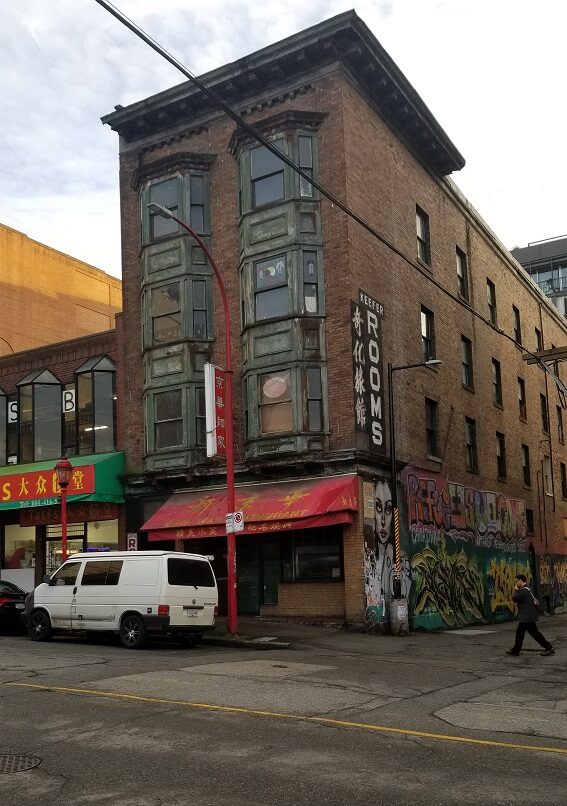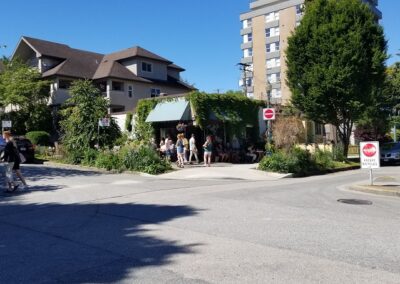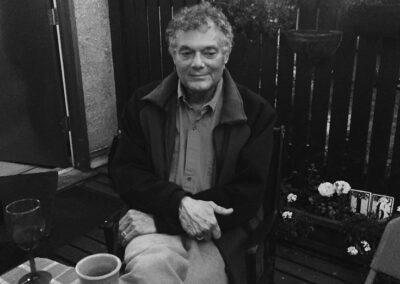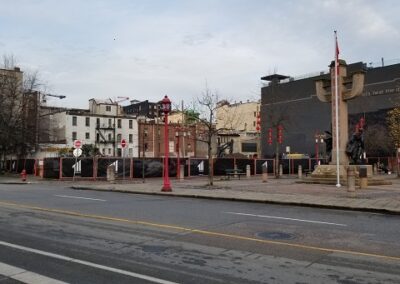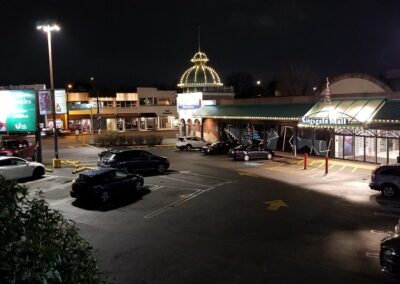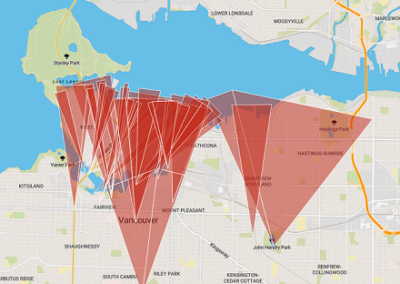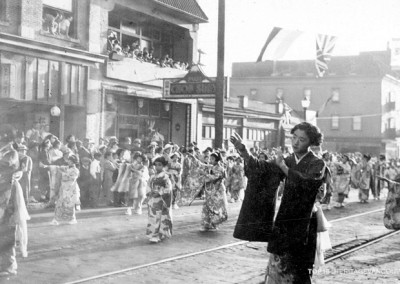On September 9, 2023 a community coalition hosted a block party at 218/222 Keefer in Chinatown to draw awareness to food security and affordable housing in Chinatown. Exactly one year earlier, a fire forced the closure of the Gain Wah restaurant on the ground level of the building and displaced 39 people living upstairs in the Keefer Rooms SRO.
The coalition is trying to bring back Gain Wah as a social enterprise -a type of business that tries to achieve its social objectives through its business operations- that can continue to serve the people in the neighbourhood as well as to help the tenants displaced by the fire return to Keefer Rooms.
About
218-222 Keefer Street is well known to historic building enthusiasts. It is a handsome brick building with six large pine green bay windows and a similarly coloured moulding that crowns the top of the building.
Next to an alley with the few remaining H-frame power poles in the city, the side of the building shows “Keefer Rooms” in English and Chinese characters painted in white on a black background above a makeshift wall of posters. The building is a “C” on the Vancouver Heritage Register and it is what most people tend to think of the heritage as being.
However, from the people with direct connections to the restaurant and the homes upstairs you learn how significant and interconnected this place is to the neighbourhood. A CBC story soon after the fire in 2022 highlighted how important Gain Wah is in an area where people do not have much money for food.
This is because of how important it is for Andrew Leung, the owner, to make food available so that people do not go hungry. “Chow mein everywhere else is $15, $16. But I said no. I’m charging $10. Why? I’d rather keep my prices down than spend money on renovations and increase the price. Why would I want to do that? I’d rather give back to the customer first,” says Andrew in a 2020 Tyee story published in the earlier days of COVID.
In that story, journalist Chris Cheung manages the challenging job of conveying what makes Gain Wah, Andrew, and long time staff Tracy and Anna so fundamentally Vancouver Chinatown and Chinese Canadian. Joshua Berson’s photos show the restaurant as if it is from a previous era; much more than nostalgia however, it is a setting that provides people struggling with the upscaling (prices and aesthetics) of their neighbourhood a sense of welcome and comfort.
Public responses to the Revitalization Survey in fall of this year sent out by the community coalition had this to say:
We lost a community-conscious social space with well priced meals to recommend to people visiting the neighbourhood, a place to meet with friends, familiar faces and caring staff.
Everything [was lost]. Chinatown lost a piece of history and something that really made Chinatown an actual Chinatown. A business owner lost his business and employees lost their jobs. It’s very traumatic for those directly affected. People lost their homes and their community.
Chinatown and Heritage
When the heritage movement gained traction in Vancouver in the 1970s, its focus was strictly on historic buildings and the preservation of those buildings. Over time, people-centred understandings and approaches started to make its way into the heritage profession. For example, this year’s theme at Canada’s national heritage conference “Transforming Heritage” was a social cultural reset, and Heritage BC’s 2024 conference is titled Prioritizing People.
In Chinatown, ideas of what exactly heritage is have been particularly contested with the first proposals for 105 Keefer over seven years ago and in 2021 City Council passed the Cultural Heritage Assets Management Plan (CHAMP) for Chinatown. A fundamental characteristic of CHAMP is that it treats heritage as a landscape in which culture and how people practice, imagine, and experience it is enmeshed in place. The emphasis is on sustaining the interaction between culture and its expressions with the physical setting of Chinatown.
CHAMP differs from past planning efforts by centering people and their values as a foundation… This means that strategies and actions aimed at protecting and promoting [Chinatown’s physical and non physical cultural] assets all share the goal of upholding the community’s cultural values and way of life.
p.17 Vancouver Chinatown Cultural Heritage Assets Management Plan
Why on Top10
For people who feel Chinatown is important because it is a place that evokes emotions, feelings and meanings through the history, social relations and the routines of daily life there, Gain Wah and Keefer Rooms is one of those anchors that makes Chinatown Chinatown. In an upscaling neighbourhood where what has value in human terms cannot compete with what is economically valuable, anchor sites are precious.
Securing Gain Wah and Keefer Rooms so that they can continue to serve Chinatown and the Downtown Eastside community members living in precarity is one of those central actions of the CHAMP framework because Gain Wah and the housing upstairs are so valuable to the landscape of Chinatown.
This effort by the coalition is the kind of heritage work that is relatively unknown. It is the kind that tries to sustain the relationship that people have with the heritage they value by nurturing and protecting the larger cultural and social setting for a historic building that many people at first thought only consider as being the heritage.
We acknowledge the financial assistance of the Province of British Columbia
